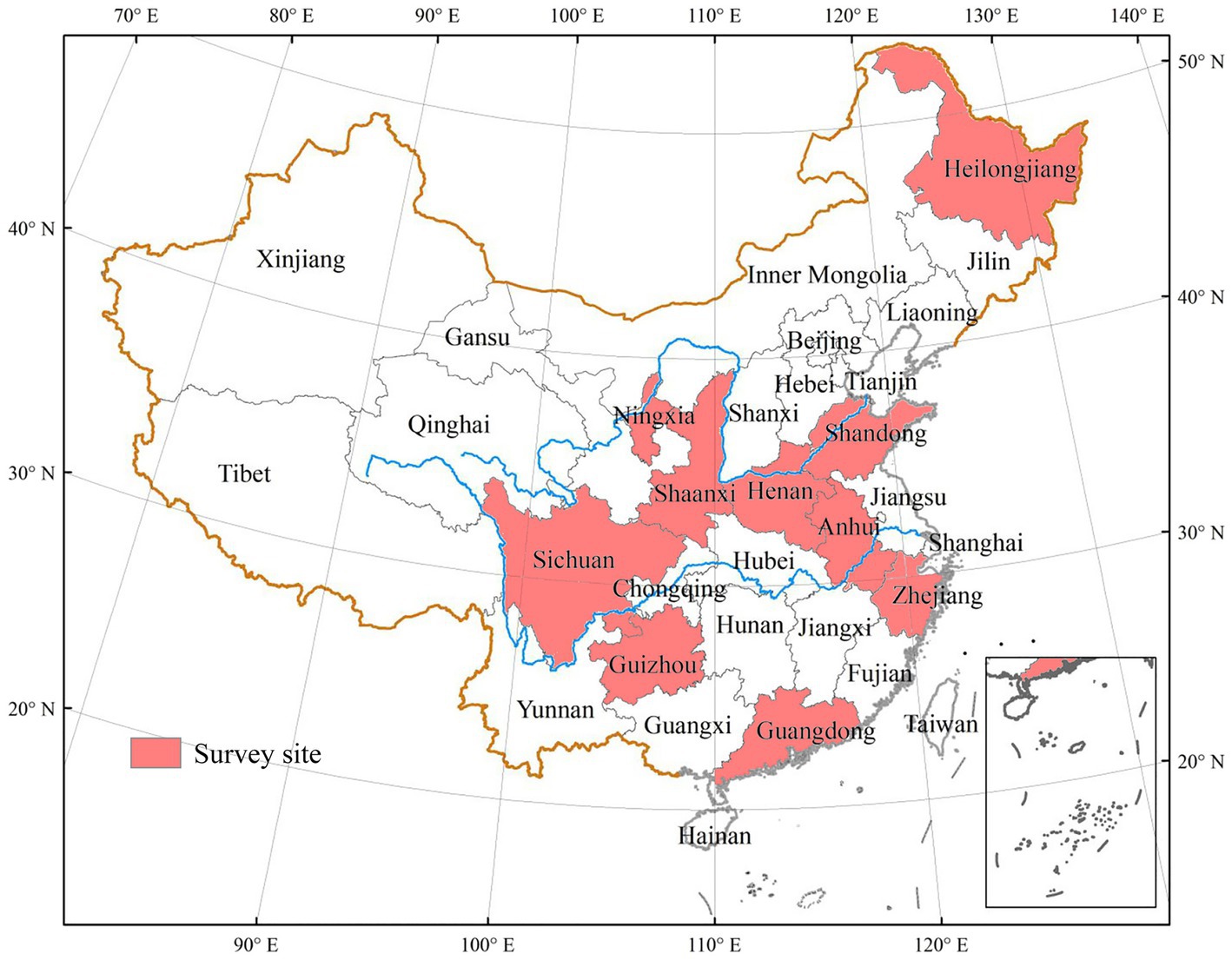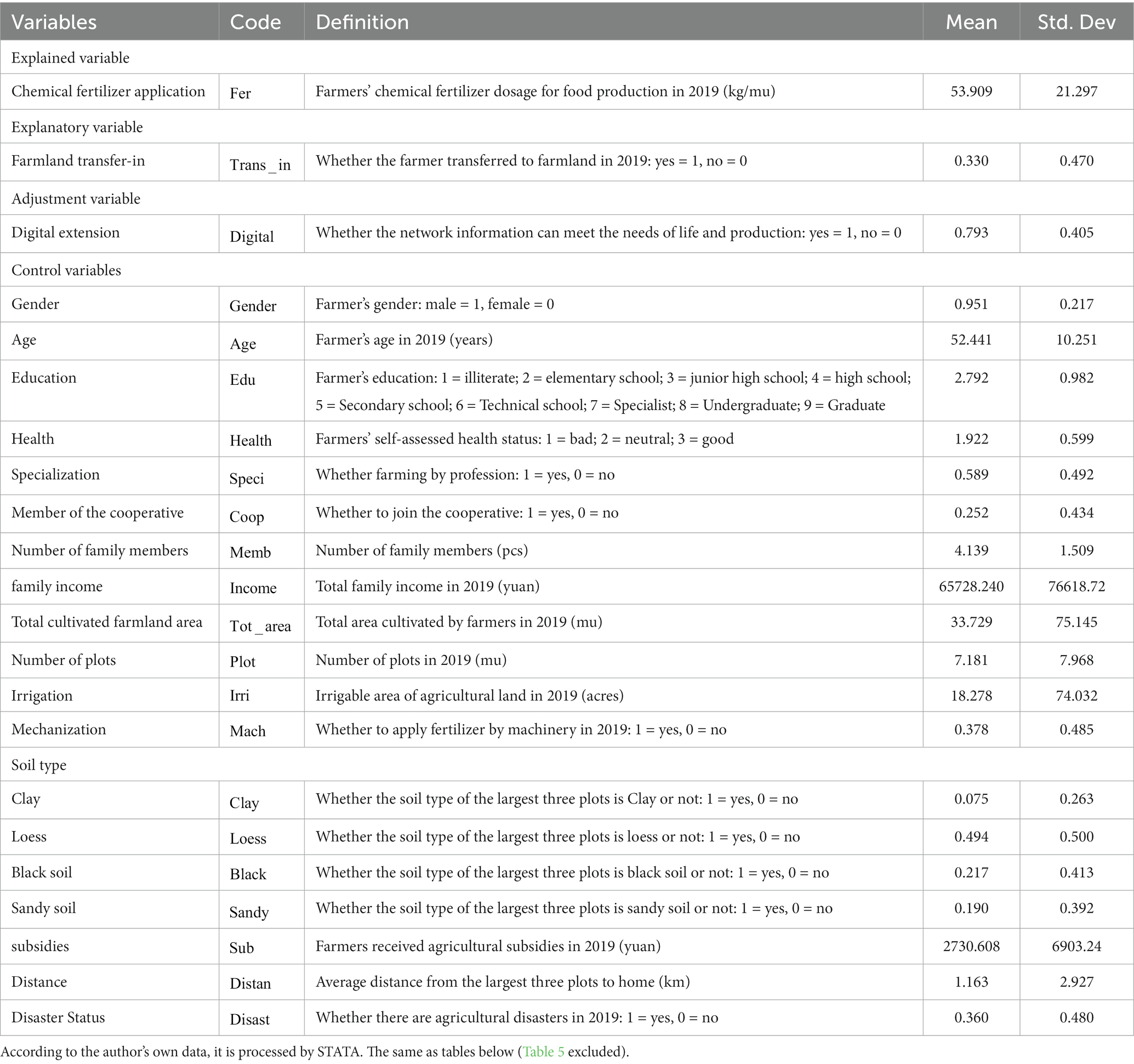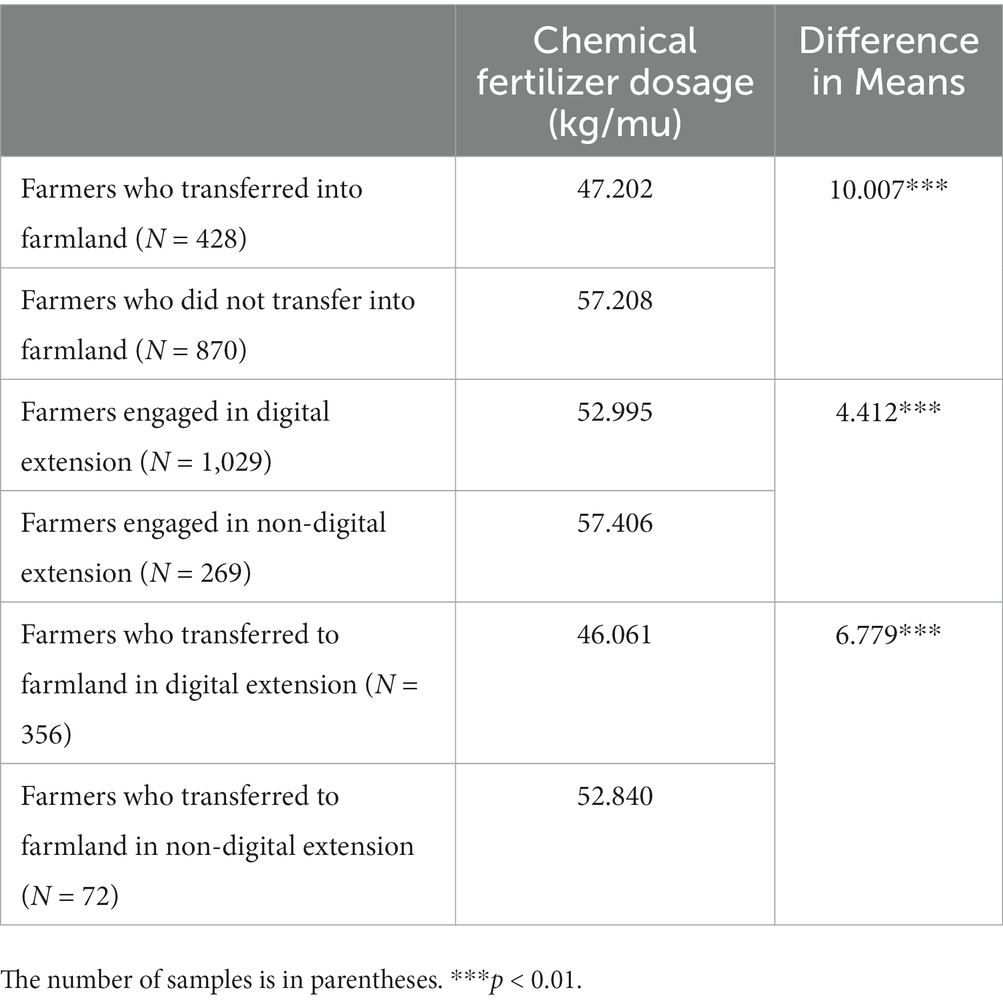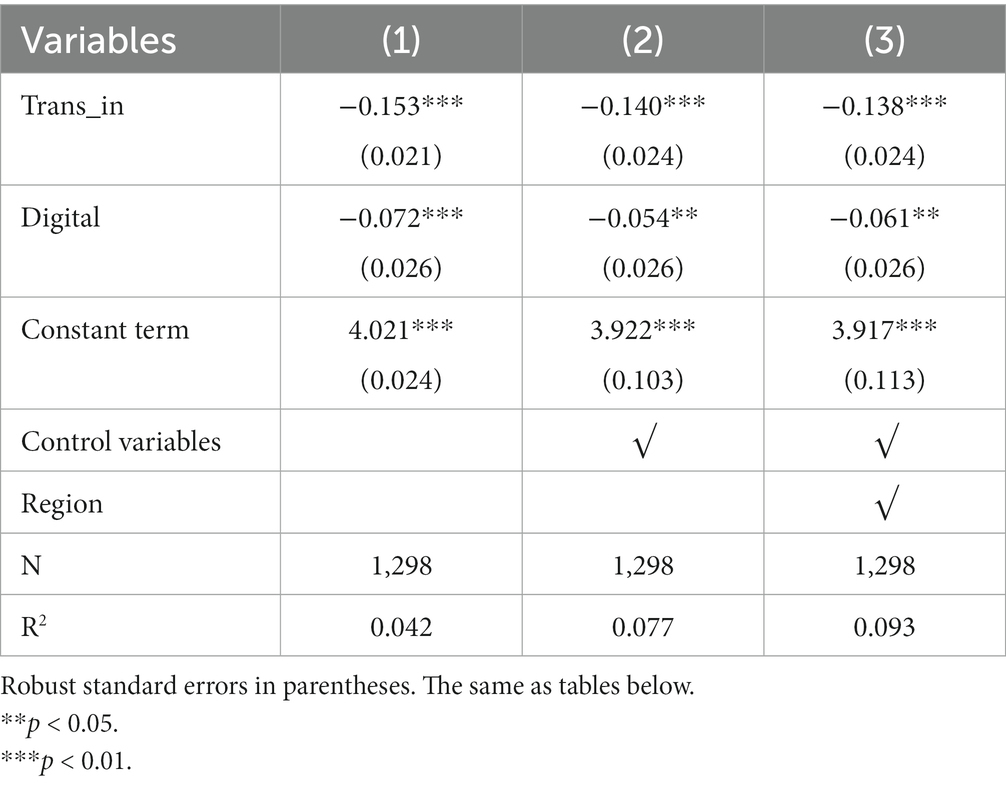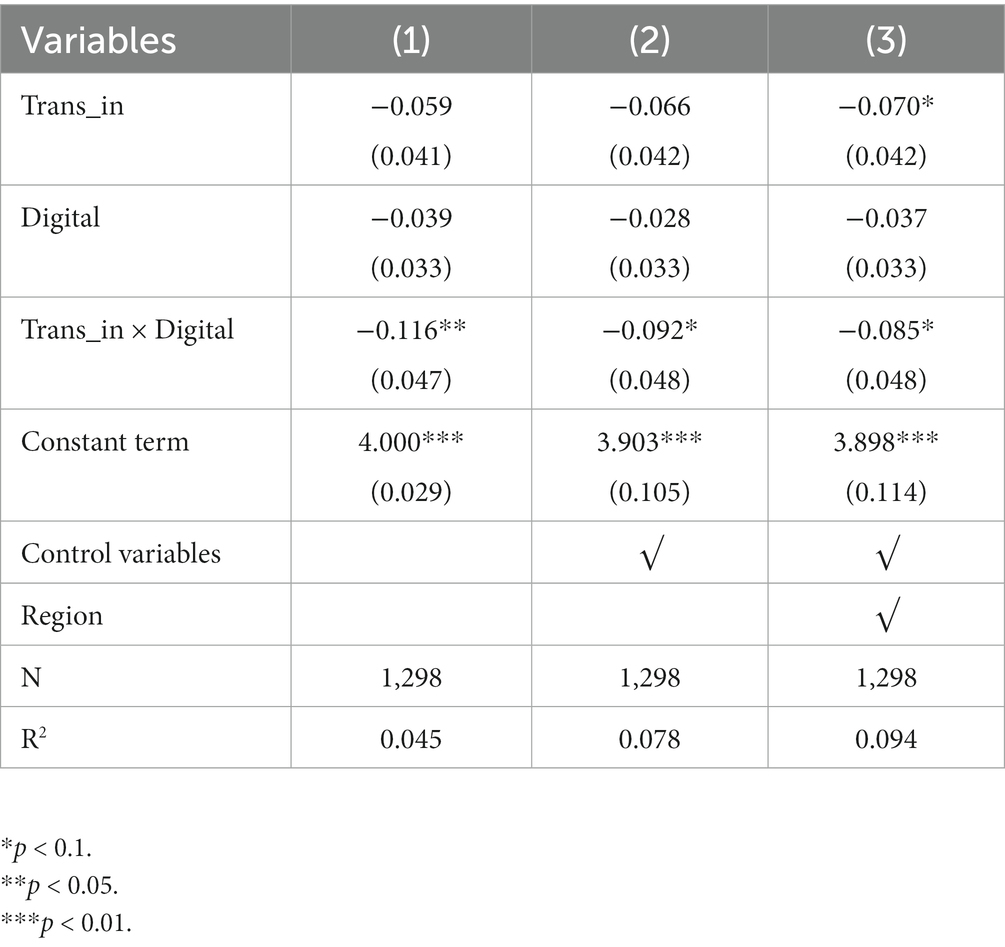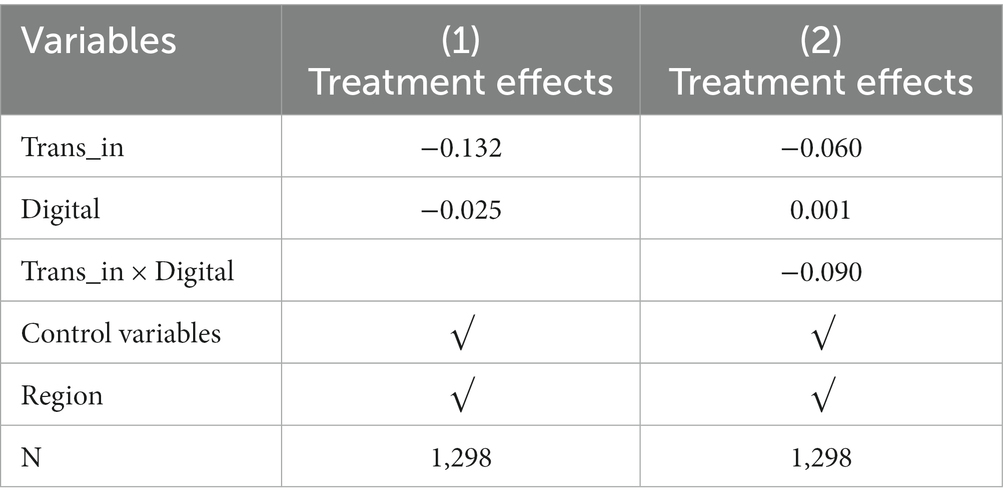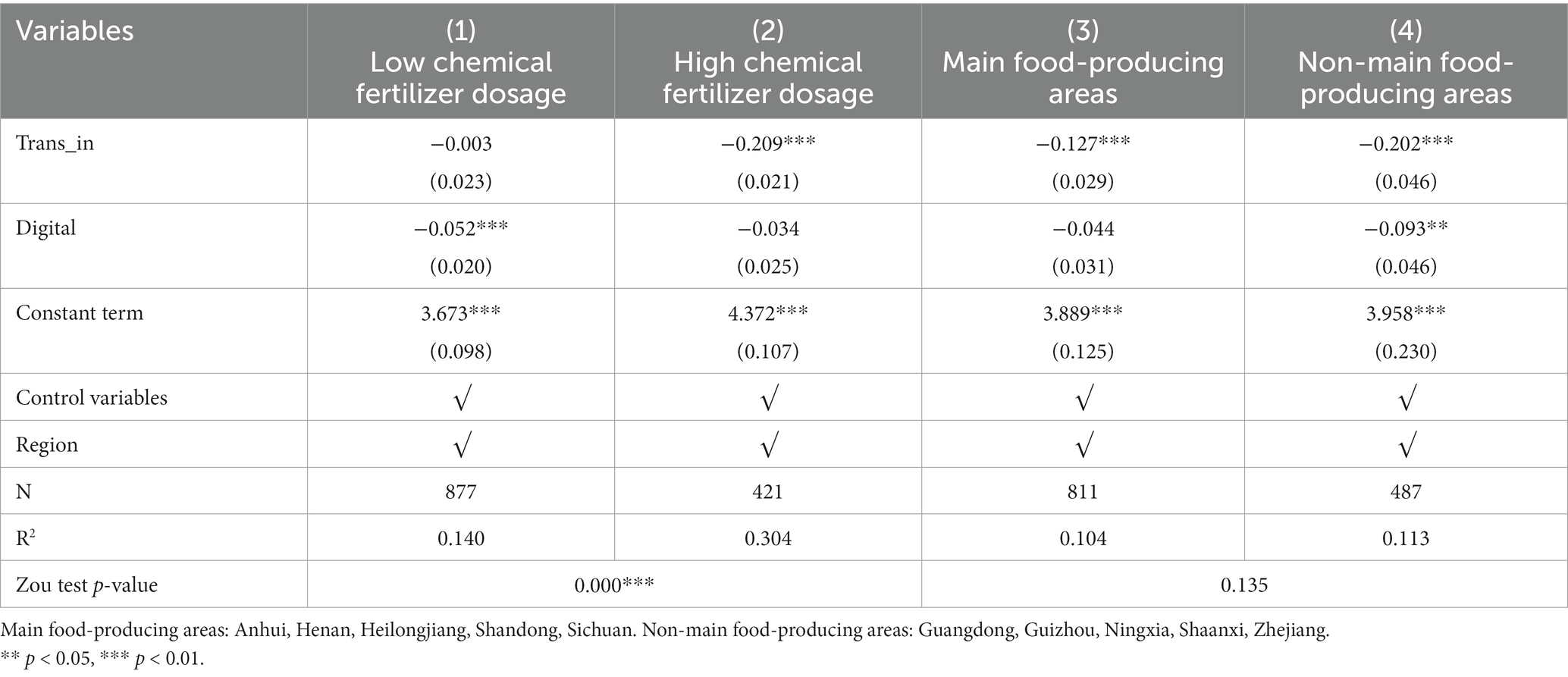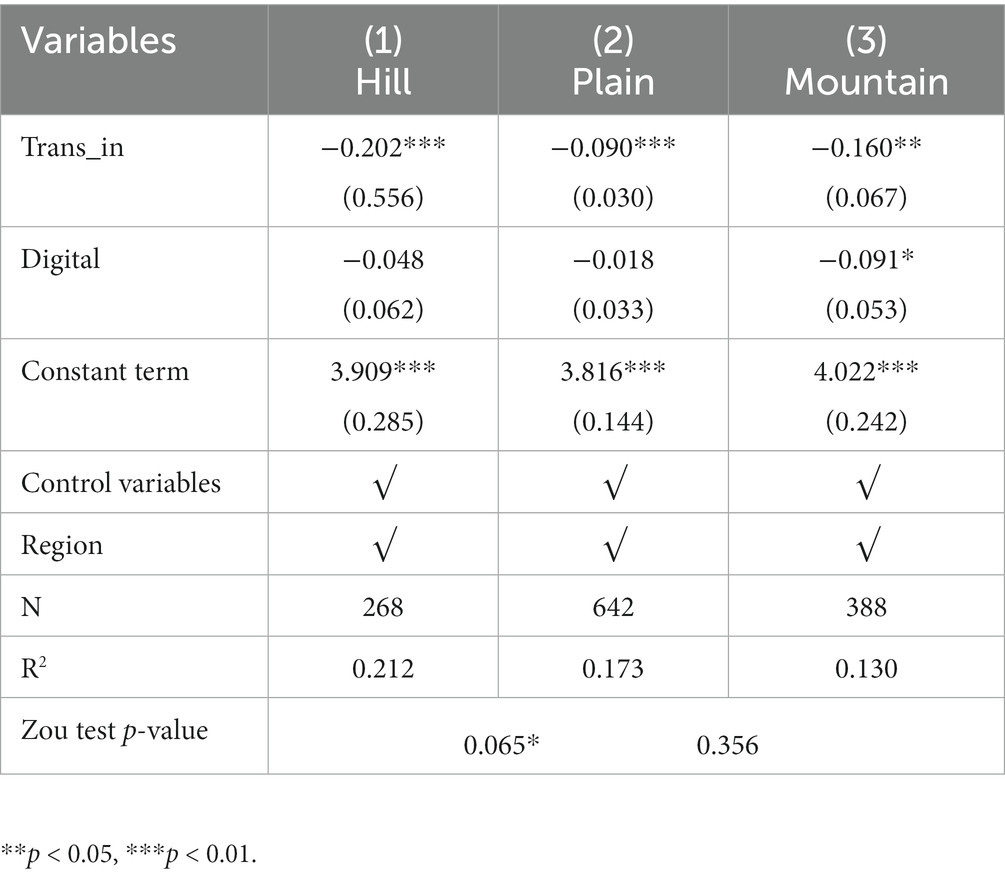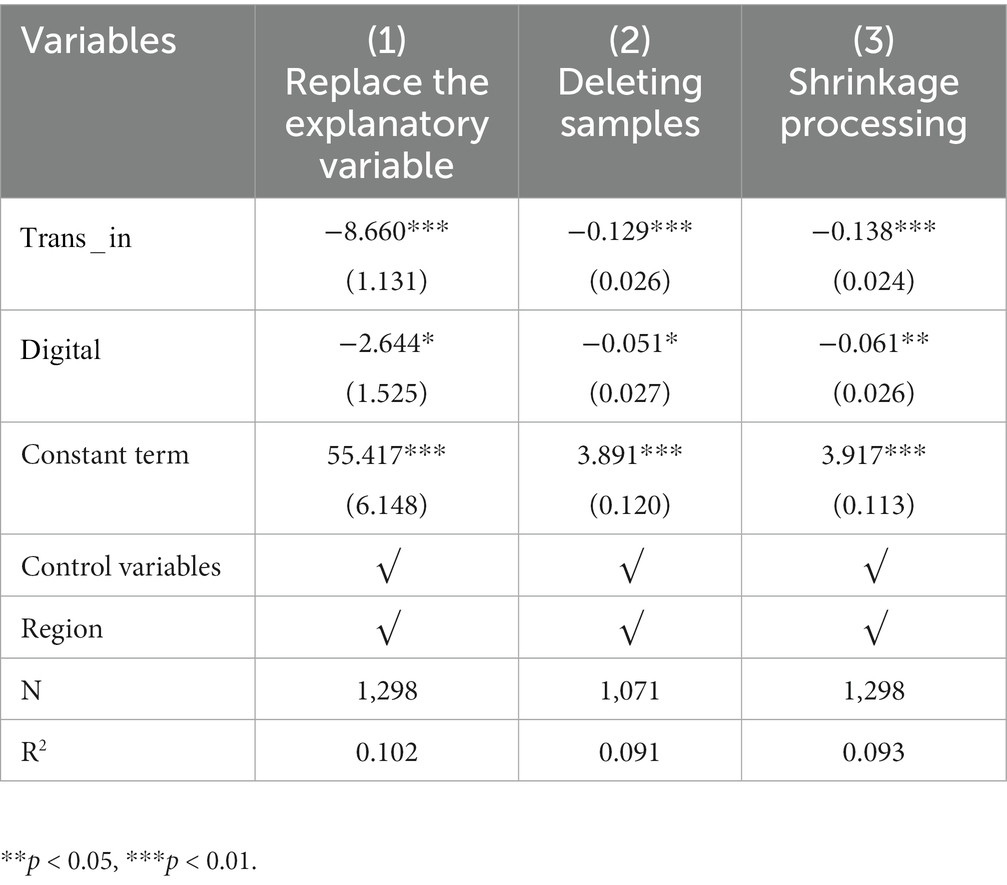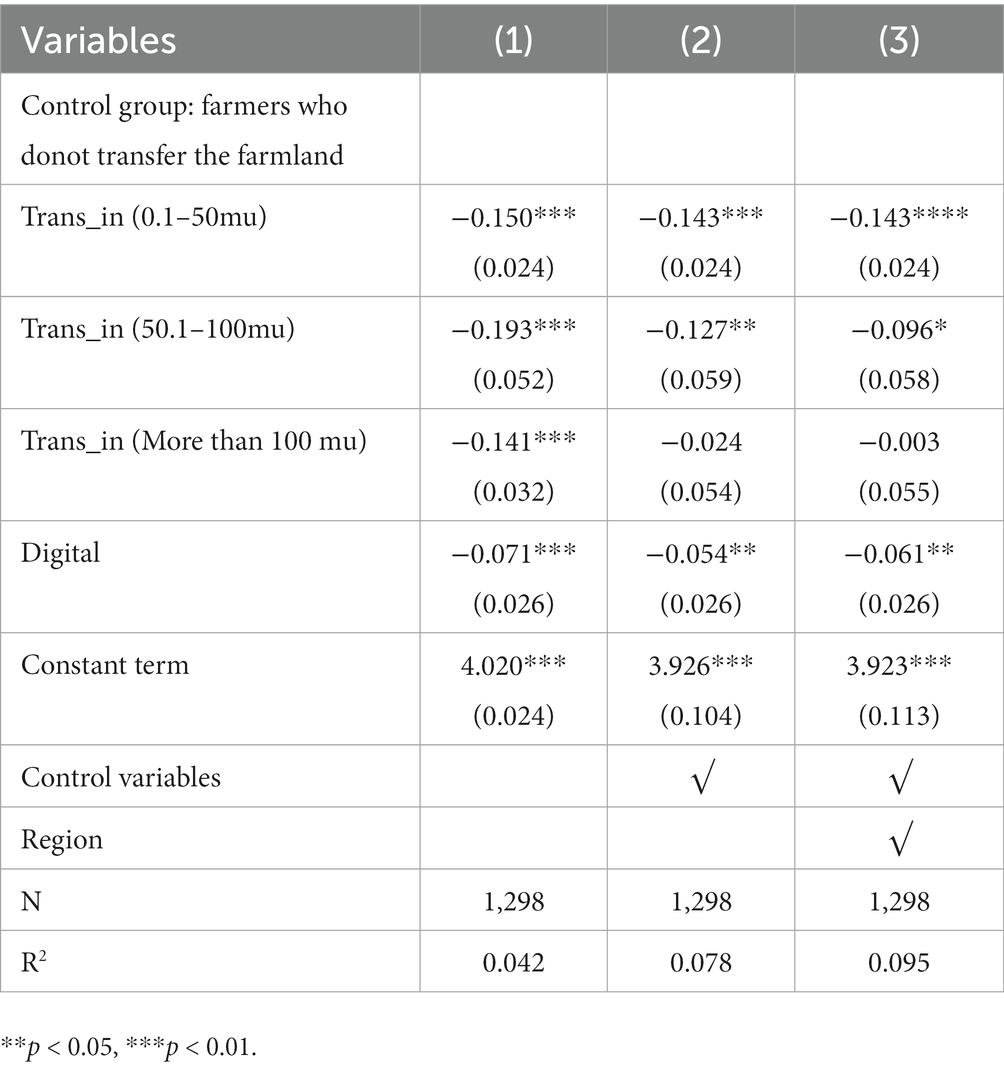- 1College of Economics, Guizhou University, Guiyang, China
- 2College of Economics and Management, Nanjing Agricultural University, Nanjing, China
In the context of rural revitalization, farmland transfer for the purpose of scale operation has not significantly promoted green agricultural development, and it is urgent to find ways to further promote farmland transfer-in to achieve chemical fertilizer reduction. Using the data of 1,298 farmers surveyed in the 2020 China Rural Revitalization Survey, this paper incorporates digital extension into the analytical framework between farmland transfer-in and chemical fertilizer reduction, analyzing their relationship in-depth. The results showed that: (1) From the basic regression results, farmland transfer-in and digital extension significantly reduced farmers’ chemical fertilizer application. (2) From the influence mechanism, digital extension played a negative moderating role in the effect of farmland transfer-in on chemical fertilizer application, reinforcing the chemical fertilizer reduction effect of farmland transfer-in. (3) From the heterogeneity analysis, farmland transfer-in has no significant heterogeneity in food function areas, but there is heterogeneity in different terrain and fertilizer dosage. (4) In terms of the scale of farmland transfer-in, when the area of transferred farmland was less than 100 mu, farmland transfer-in significantly reduced chemical fertilizer application; otherwise, farmland transfer-in did not achieve chemical fertilizer reduction. The above findings provide a reference for promoting moderate-scale farmland transfer and synergistic construction of farmland scale operation and digital extension.
1. Introduction
The overuse of chemical fertilizers has severe impacts on human health and the environment. According to Chen et al. (2014) and Chaudhary et al. (2021), excessive fertilizer use not only leads to water pollution and poses a direct threat to human health, but also aggravates greenhouse gas emissions by inhibiting soil carbon sequestration. In China, the problem of excessive fertilizer application and inefficient use is prominent. China had 8% of the world’s farmland but consumed 25% of chemical fertilizer (Xinhua News Agency, 2015). According to statistics (NBSC, 1979-2022), Chemical Fertilizer Application (CFA) increased from 58.89 kg/ha in 1978 to 307.73 kg/ha in 2021, which is much higher than the universal safety standard (225 kg/ha). However, excessive CFA is not conducive to food productivity (Krugman, 1994). The average annual growth rate of CFA in China was 9.83% during 1978–2021, while the average annual growth rate of food yield was only 2.85% (NBSC, 1979-2022). It is evident that a high CFA is not an effective way to achieve sustainable agricultural development (Huang and Jiang, 2019). Therefore, exploring how to achieve Chemical Fertilizer Reduction (CFR) in China is essential.
Chinese farmland operations are narrow and fragmented, and farmers have little incentive to invest in advanced technology and machinery, hence, preferring to increase CFA to maximize land yields (Lin, 1992; Zhong and Ji, 2009). In the last decade, China has implemented the system for separating the ownership rights, contracting rights, and management rights, which provides the institutional basis for transferring farmland. Farmland transfer refers to farmers transferring management rights of their contracted land to other farmers or economic organizations through legal forms. In this regard, promoting Farmland Transfer-in (FTI) may be a solution to reduce CFA (Huan and Zhan, 2022). After transferring into farmland, farmers can expand agricultural output by inputting material factors such as land and capital. This will motivate farmers to make long-term production investments, including adopting green fertilization technologies and improving mechanization, thus eventually reducing CFA (Ju et al., 2016; Wu et al., 2018; Zhong et al., 2021). Therefore, promoting FTI is a crucial way to achieve CFR. With the rural revitalization strategy implemented, the rate of FTI in China has achieved a large increase (Xiao and Luo, 2023). According to the China Agricultural Yearbook (MAC, 2011, 2021), the farmland transfer area in China was 532 million mu in 2020, an increase of 326.62% compared to 2010, however, the CFA only decreased by 9.42% (NBSC, 2011–2021). It is not difficult to find that FTI has not dramatically reduced CFA, indicating a mismatch between the rapid development of FTI and the slow decline of CFA in China, and the intrinsic motivation of large-scale farmland operations to reduce CFA still needs to be improved. In response, we cannot help but ponder whether FTI can reduce CFA in the context of liberalizing farmland management rights. Whether a new path can be found to promote the CFR effect caused by the FTI further? If so? What are the possible theoretical mechanisms?
The existing literature focus on the relationship between FTI and CFA (Ju et al., 2016; Wu et al., 2018; Liang et al., 2020), ignoring an important condition: the substantial reduction in CFA through farmland scale operation needs to depend on the new agricultural business entities (large professional households, family farms, farmer cooperatives and leading agricultural enterprises; Xiao and Luo, 2023). However, up to now, the participants of FTI are mainly smallholder farmers (People’s Daily, 2022). Due to human capital constraints, smallholder farmers’ fertilizer-increasing behavior inertia will be solidified with the risk of introducing new technologies, which can prevent their need to adopt fertilizer-reducing technologies and hinder the fertilizer-reducing process in the transfer of farmland. Regarding how to improve the human capital of smallholder farmers, it has been suggested that traditional technology training can increase the human capital of most farmers and improve their perception of the advantages and disadvantages of CFA, but FTI weakens the CFR effect of technology training (Liu et al., 2022). Evidently, traditional agricultural technology training has yet to truly motivate farmers of transferring to farmland to adopt green technologies (You and Wu, 2010). Therefore, there is an urgent need to find an effective way that promotes FTI to reduce CFA.
Compared with traditional technology training, new Digital Extension (DIE) can overcome temporal and spatial constraints, customize production advice for farmers, truly alleviate information asymmetry, and facilitate farmers to optimize resource allocation (Dzanku et al., 2020; Mao et al., 2022). Currently, digital technologies have improved the “digital divide” in rural areas at the stage of Internet access and use (Chipeva et al., 2018). This alleviated the dual resource and information constraints in the lives of farm households and influenced their production decisions. Moreover, DIE relies on the advantages of information and communication technology such as providing farmers with timely and effective technology adoption advice based on local climate and resources, and guiding farmers to apply chemical fertilizer effectively and efficiently (Saito et al., 2015). More so, DIE can broaden information channels to provide market demand information, and improve farmers’ perception of the economic benefits of CFR, thus incentivizing farmers to reduce CFA to meet market demand (Chen et al., 2023). The mentioned studies suggest that DIE may further contribute to the CFR effect caused by the FTI, but do not establish the linkage between FTI, DIE, and CFR. Therefore, this paper attempts to integrate DIE into the analytical framework between FTI and CFR, providing a reference for promoting green agricultural development.
Based on the data of 1,298 farmers surveyed in the 2020 China Rural Revitalization Survey, this paper explores the relationship among FTI, DIE, and CFR from theoretical and empirical perspectives. Compared with existing studies, the marginal contributions of this paper are: First, observing the mismatch between the rapid advancement of FTI and slow progress of CFR, from the perspective of DIE, this study empirically examines its moderating role between FTI and CFR, and provides a new way for FTI to promote CFR better. Second, according to the theories of “transaction cost” and “information dissemination,” this paper constructs a theoretical framework of FTI, DIE, and CFR, and complements the influence mechanism of FTI on CFR. Third, we explore the impact of different transfer-in farmland scales on farmers’ CFA, and provide policy implications for moderate-scale farmland transfer. Finally, this paper used the Bayesian Additive Regression Tree (BART) algorithm to mitigate endogeneity, optimizing the problems of existing studies using the Propensity Score Matching method, and improving the accuracy of causal identification.
The remainder of this paper is structured as follows. The second section explains the concept of DIE and presents the research hypothesis based on the theoretical analysis. The third section describes data sources, model construction, the indicators constructed from the data, followed by some descriptive statistics, The fourth section comprises of the empirical analysis and discussion of the results. The paper ends with making some concluding remarks and presenting policy implications.
2. Concept definition and theoretical analysis
2.1. Concept definition
Digital extension refers to spreading information, technology, products, and services through Internet technology and digital interactive media, with characteristics such as various forms, minimized cost, and personalized service (Oyinbo et al., 2021; Mao et al., 2022). DIE is not currently measured uniformly. For example, most micro studies use a single information and communication device to measure DIE (Hübler and Hartje, 2016; Ma and Wang, 2020; Yuan et al., 2020), while macro studies use regional Internet penetration to represent it (Chen et al., 2023). However, the above studies do not meet the various feature of extension forms. For instance, smartphones, tablets, or computers can be used as information dissemination media to conduct DIE. Furthermore, the interaction between humans and technology is the key to the value of technology. DIE can provide personalized service by increasing the effectiveness of interaction with various forms, but personalized service is often neglected (Fielke et al., 2021; McCampbell et al., 2021). In order to overcome the shortcomings of existing studies, this paper uses “whether the network information can meet the daily needs of production and life” to measure DIE. The reasons are as follows: For various forms, network accessibility can support multiple devices such as smartphones, tablets, and computers. For personalized service, we match it with “whether information can meet the daily needs.”
2.2. Farmland transfer-in and chemical fertilizer reduction
Due to agricultural factors with more people and little land, China’s farmland is dominated by small-scale and fragmented operations (Liang et al., 2020), which restricts agricultural modernization. To solve the problem, the government has continuously improved the farmland system and moderately promoted FTI, which has profoundly affected CFR in agricultural production.
After farmers transfer into farmland, the expansion of farmland scale reduces the average production cost, improves agricultural production efficiency by changing factor inputs, and promotes CFR. For one thing, green fertilization techniques are introduced to reduce CFA. The fixed cost of green fertilizer technologies is high, limiting farmers’ willingness to adopt them. However, FTI improves the economies of scale in agricultural production and motivates farmers to adopt high-quality fertilizers to get long-term returns (Wu et al., 2018), so farmers who transfer into farmland are more likely to adopt green fertilization techniques. Balanced fertilization, formula fertilization by soil testing, and organic fertilizer replacing chemical fertilizer meet the nutritional needs of crops and also increase chemical fertilizer utilization rate and avoid excessive use (Ye et al., 2020). Another thing is the upgrading of agricultural mechanization level to achieve CFR. FTI optimizes field roads through plot consolidation, and similarly offers agricultural machinery convenient conditions, such as the fertilizer application machine (Liang et al., 2020). Therefore, compared with those who do not transfer to farmland, farmers who transfer to farmland usually are more willing to use agricultural machinery (Paudel et al., 2019; Qing et al., 2023). Hence, the fertilizer dosage of the fertilizer application machine is fixed per unit of time and area by standardized operation, which is conducive to CFA.
Therefore,
Hypothesis 1 is put forward: FTI is beneficial to achieving CFR.
2.3. Farmland transfer-in, digital extension, and chemical fertilizer reduction
In Section 2.1, the theoretical analysis implicitly assumes that the transaction relationship is stable enough and farmers are “perfectly rational.” For the former, Wang and Gu (2016) argued that the management and contracting rights of transfer-in farmland have dispersed, and have affected the transaction relationships of farmland transfer subjects and caused higher transaction costs, so achieving moderate-scale farmland management is long-term and challenging. Specifically, farmers who transfer out of farmland to non-farm employment still consider farmland as a backroad with both production resources and social security (You and Wu, 2010); owing to the instability of management rights, farmers who transfer into farmland may increase CFA to reduce the expected risk (Lu et al., 2019; Hu et al., 2021). For the latter, according to the risk decision theory, farmers are “finite rational persons” (Liu et al., 2022). FTI is an agricultural investment, and CFR technologies will expose returns to uncertain risks, so over-inputting fertilizer is farmers’ habitual behavior (Deaton et al., 2018). The drawbacks, including high transaction costs causing inconsistent rights holders and potential risks in adopting CFR technologies, hinder the possibility of further CFR through FTI, which may explain the mismatch between the rapid advancement of FTI and the slow progress of CFR.
For reducing transaction costs and improving farmers’ risk perceptions in FTI, several studies have concluded that Internet use can expand farmers’ social networks, reduce transaction costs, and thus promote FTI (Wu et al., 2012; Zhang et al., 2022). Mao et al. (2022) found that DIE can improve perceptions of CFR and enhance green fertilization technology alternatives to CFA, and prompted farmers to green production. These studies provide a reference for this paper to verify that DIE may further promote FTI to realize CFR. However, they did not investigate the influence mechanism between the three. Therefore, we will construct a theoretical framework of FTI, DIE, and CFR according to the theory of “transaction cost” and “information dissemination.”
Based on the “transaction cost” theory, market information is incomplete. Under the limited information, the transaction cost of the traditional farmland transfer market is high (Li et al., 2023), which inhibits farmers from adjusting the farmland’s scale corresponding to their management ability. However, DIE, with wide spatial coverage and cost minimization (Mao et al., 2022), breaks through the spatial and temporal limitations in the farmland market, and places farmland transfer transactions on the accessible information. So, DIE not only reduces the search cost in the transaction process but also improves farmers’ bargaining power by expanding the transaction scope, and thus promoting FTI on a moderate scale. After transferring to farmland, the scale of farmland can reach the threshold of socialized services, making it possible to accelerate CFR through socialized services (Zhong et al., 2021). In the traditional socialized service market, the supply (socialized service organizations), and the demand (farmers transferring into farmland) cannot be matched effectively due to information asymmetry. Fortunately, on the one hand, DIE can take advantage of technology interaction and service radius expansion to provide technology and service display platforms for farmers, thus enhancing their autonomous selectivity and reducing the search and bargaining costs of using socialized services (Ma et al., 2022). On the other hand, as the social service platform is supported by digital technology, farmers can monitor the production dynamics of social service organizations in a timely and efficient manner, which avoids the moral risks of social services and reduces the supervision cost of farmers and further motivates them to adopt social services. Furthermore, socialized services can achieve CFR by spreading green production concepts, advanced green technologies, and market-based reputation constraints (Rada and Fuglie, 2019; Huan and Zhan, 2022).
Based on the “information dissemination” theory (Aker, 2011), DIE provides farmers with various and personalized information through Internet technology, which increases the stability of non-farm employment for farmers transferring out of farmland and improves the risk perception of farmers transferring into farmland and promotes CFR. This is divided into two areas as follows.
First, due to the dispersal of farmland management and contracting rights, farmers who transfer into farmland have less incentive to invest in production, inhibiting the CFR effect caused by the FTI. In this regard, Zhong and Ji (2009) suggested that the stability of non-farm employment of farmers who transfer out of farmland could play a vital role in the productive investment of farmers who transfer into farmland. On the one hand, DIE broadens the social network of rural laborers through information and communication technology and provides more information channels for non-farm employment (Yuan et al., 2020). On the other hand, DIE also improves the initiative of non-farm employment by disseminating information on skills training, thus enhancing the stability of non-farm employment of farmers who transfer out of farmland (Zhang et al., 2022). Once the stability of non-farm employment increases for farmers transferring out of farmland, farmers transferring into farmland will reduce the risk of unstable management rights. Thus, farmers transferring into farmland will be more inclined to pursue long-term profits and increase their investment in transferred farmland (Su et al., 2018), such as actively applying green agricultural techniques, while realizing CFR.
Second, after transferring to farmland, farmers face agricultural production information restraint (Parmar et al., 2019) and are at higher risk of adopting CFR technologies. DIE can drive farmers from “touch the Internet” to “use the Internet” with diversified information dissemination methods, deeply integrated into the pre-production, mid-production, and post-production links of agriculture, and provide farmers with personalized information and technical guidance on CFA, so as to achieve CFR. The first is the information dissemination effect in the pre-production stage. Information dissemination is critical in farmers’ technology adoption behavior (Genius et al., 2014; Magnan et al., 2015). DIE optimizes the access and quality of information, conveys timely market orientation, and improves farmers’ perceptions of ecological product benefits, which motivates them to reduce CFA to improve the quality of agricultural products (Bhimanpallewar and Narasingarao, 2020; Zhao et al., 2021). The second is the technological innovation effect in the mid-production stage. DIE can guide farmers with personalized CFR information according to their needs, such as fertilizer application time, applying additional fertilizer, application frequency, dosage, etc. This will strengthen farmers’ knowledge of green fertilizer application technology, reduce the risk and cost of blindly adopting it, and motivate farmers to adopt CFR technology (Fernando, 2021; Mao et al., 2022). For example, DIE not only facilitates communication between farmers and agricultural scientists by building web service platforms like APPs and Public accounts, which break the information barrier of CFR technology; but also offers farmers personalized production advice by combining information on weather, production conditions, and market prices. The third is the information traceability effect in the post-production period. DIE can break the time–space restriction, and realize the direct connection between the supply and demand side of green agricultural products. After consumers receive agricultural products, they will use the Internet to trace the quality and safety information of products, and learn the whole industrial chain links through “one thing, one code.” This will force farmers who transfer to farmland strictly control the quality of agricultural products by reducing the CFA, thus promoting green agricultural production.
Therefore, the following two hypotheses are proposed:
Hypothesis 2: DIE can significantly contribute to CFR.
Hypothesis 3: DIE plays a negative moderating role in the effect of FTI on CFA, meaning DIE can further promote the CFR effect caused by the FTI.
3. Data sources, model construction and variable description
3.1. Source of data
The study used data from the China Rural Revitalization Survey conducted by the Institute of Rural Development, Chinese Academy of Social Sciences in 2020. By using farmers’ responses to questions posed by the survey, the survey collected 3,833 farmers’ data from 10 provincial administrative units, including Guangdong Province, Zhejiang Province, Shandong Province, Anhui Province, Henan Province, Heilongjiang Province, Guizhou Province, Sichuan Province, Shaanxi Province, and Ningxia Hui Autonomous Region (as shown in Figure 1), covering rural population, rural industrial structure, farmers’ income and expenditure, rural governance, etc. For the sampling method, the survey first considers the economic development, agricultural situation, and regional location of each place, randomly selects sample provinces, and then uses an equidistant random sampling method to select sample villages, ensuring the representativeness and validity of samples. In this paper, we retained samples of key variables such as FTI, DIE, and CFA, and finally obtained sample data of 1,298 farm households. Among them, the number of farmers who transfer into farmland is 428, and the number of farmers who transfer out of farmland is 870.
3.2. Datum model setting
To test Hypothesis 1 and Hypothesis 2 proposed by the above theoretical analysis, considering also that the explained variable is a continuous type variable, this study first constructs the model expressions without the cross-term as follows:
Here, denotes the average CFA (kg/mu) of the farmer, considering that the variance of increases as the farmland scale increases, so it is logarithmized to alleviate the heteroscedasticity problem (Liang et al., 2020); is a dummy variable, meaning the transfer behavior of the farmer, if the farmer transfer into the farmland, , otherwise, ; stands the DIE status of the farmer, which is measured by whether the network information can meet the needs of life and production, and is also a dummy variable, with the same value as ; is a series of control variables; denotes regional fixed effects; denotes random error term. is the intercept term, 、 、 are parameters to be estimated. To further test hypothesis 3, the cross-term between FTI and DIE is added to the model, which can be expressed as follows:
Here, denotes the cross-term of FTI and DIE, is the intercept term, 、 、 、 are the parameters to be estimated, and the meanings of other variables are the same as in (1).
3.3. Variables selection
3.3.1. Explained variable
Referring to a relevant study (Liang et al., 2020), this paper uses the average CFA of food crops (kg/mu) to represent the fertilizer application behavior of farmers.
3.3.2. Explanatory variable
FTI is measured by whether the farmer transfers into farmland.
3.3.3. Adjustment variable
Based on the concept of DIE in Section 2.1, this paper uses “whether the network information can meet the needs of production and life” to measure DIE. If the network information can meet the needs of production and life, farmers can be considered to engage in DIE; otherwise, farmers are not involved in DIE. Control variables.
3.3.4. Control variables
Following a wide range of literature (Saito et al., 2015; Yuan et al., 2020; Hu et al., 2021; Mao et al., 2022), we can select the following control variables: (1) Farmers’ individual characteristics, including gender, age, education level, health status, specialization, and whether to join the cooperative. (2) Farmers’ household characteristics, including the number of family members and total annual income. (3) Agricultural production characteristics variables, including total area cultivated by farmers, number of plots, soil type, irrigation conditions, and mechanization level. (4) The external environment of agricultural production, including agricultural subsidies, disaster status, and distance from the farmland to home.
3.4. Description of the variables
The meanings and descriptiveness of the variables are shown in Table 1. Table 1 indicates the average CFA of the sample farmers was 53.909 kg/mu, which is similar to the finding of the third agricultural census from China in 2016 (53.80 kg/mu; Zhong et al., 2021), indicating that the sample data are generally representative. Among the farmers in the sample, 33.0% of them transferred to farmland, and 79.3% thought that the information obtained through the network could meet their needs of living and production.
In addition, to see more intuitively the relationship between FTI, DIE, and CFR, a preliminary investigation was conducted in this paper, and the results are shown in Table 2. The results of the independent distribution t-test showed that the CFA of the farmers’ group who transferred into the farmland (47.202 kg/mu) was significantly lower than that of the farmers’ group who transferred out of the farmland (57.208 kg/mu). And the CFA of farmers in the DIE group (52.995 kg/mu) was obviously lower than that of farmers in the non-digital extension group (57.406 kg/mu). Among the farmers who transferred into the farmland, the CFA in the DIE group (46.061 kg/mu) was much lower than that of farmers in the non-digital extension group (52.840 kg/mu). Although the above descriptive analyses could verify the hypotheses proposed in the theoretical analysis to some extent, they did not control other variables and only reflected the correlation between variables, which still requires further econometric analysis.
4. Results and discussions
4.1. Baseline regression analysis
Before conducting the multiple regression analysis, this paper verified the four aspects of correlation of variables, normality of residuals, independence and homogeneity of residuals, and the results showed that the data in this paper can meet the data distribution requirements of multiple regression analysis.
Table 3 shows the basic regressions of the effects of FTI and DIE on CFR. From column (1) to column (3), after controlling no variables, adding control variables, and area fixed effects, there is a significant negative effect of FTI and DIE on fertilizer use, indicating FTI and DIE notably contribute to CFR. This regression result is consistent with the previous theoretical expectation and validates Hypothesis 1 and Hypothesis 2. Compared with columns (1) and (2), the regression in column (3) better mitigates the omitted variable problem, and the regression results based on column (3) are below. FTI can reduce 13.8% CFA of farmers, which means FTI helps to achieve CFR. The reason is that, on the one hand, FTI can improve the economy of scale in agricultural production (Liang et al., 2020; Huan and Zhan, 2022), reduce the marginal cost of using machinery and CFR technology, stimulate farmers’ incentive to invest in production, reduce their reliance on chemical fertilizer elements (Zhong and Ji, 2009), and thus promote CFR. On the other hand, regardless applying mechanical fertilization or adopting green fertilization technology (balanced fertilization, formula fertilization by soil testing, etc.) can improve the efficiency of chemical fertilizer utilization and avoid farmers’ blind input of chemical fertilizer. As to whether FTI can promote farmers’ adoption of green fertilization techniques and improve mechanization, much research has been done (Ju et al., 2016; Huang and Jiang, 2019; Paudel et al., 2019; Hu et al., 2021), and will not be verified in this paper.
In addition, DIE can also CFA by 6.1%, probably because, DIE conveys the ecological and economic benefits of CFR to farmers through various publicity methods, which increases farmers’ initiative to adopt green fertilizer application technologies and motivates them to achieve CFR (Mao et al., 2022; Chen et al., 2023). Also, DIE provides farmers with highly targeted information on fertilizer application through personalized services (Saito et al., 2015; Fernando, 2021), which improve their knowledge structure on fertilizer application and reduce their risk of blindly adopting CFR technologies, thus strengthening their motivation to adopt CFR technologies and promote CFR.
4.2. Mechanism analysis
The results in Table 3 demonstrate that FTI can promote CFR, which is consistent with most studies (Paudel et al., 2019; Rada and Fuglie, 2019; Liang et al., 2020; Hu et al., 2021). However, this does not reveal the mismatch between the rapid development of FTI and the slow decline of CFA. Noteworthy, the analysis in section 4.1 also verifies the CFR effect caused by DIE, which may be a new path to promote FTI to reduce the CFA further. To prove this path, we added the cross-term between FTI and DIE in the regression analysis, and the results are shown in Table 4. The regression results show that the cross-term is significantly negative at the 10% level, validating Hypothesis 3. This result implies that DIE plays a negative moderating role in the effect of FTI on chemical fertilizer use, meaning when farmland is transferred into, DIE can further reduce the CFA and enhance the CFR effect caused by the FTI. The reason is that DIE relies on the advantages of a wide service radius and cost minimization to reduce transaction costs (Mao et al., 2022; Zhang et al., 2022). This broadens the scope of transactions and realizes the integration of capital, technology, and information resources, which increases the efficiency of FTI while strengthening the scale effect of FTI. It also boosts the specialized production of farmers transferring into farmland (Ma et al., 2022), improves chemical fertilizer utilization, and thus realizes the reduction of fertilizer. Then, by disseminating employment information and providing skills training in various ways, DIE can improve the employment stability of farmers transferring out of farmland (Yuan et al., 2020), which in turn reduces the instability of management rights of farmers transferring into farmland, lessens their short-sighted production behavior, and motivates them to use CFR technologies (Su et al., 2018). Besides, DIE can provide farmers with tailored advice on agronomic adoption and green fertilization, so that they can fully access information on CFR technologies and indeed facilitate the transition from CFR awareness to practical action, ultimately realizing green production.
4.3. Endogeneity analysis
Although this paper has controlled for observable factors such as individual and household characteristics of farmers, agricultural production characteristics, and the external environment of agricultural production, farmers’ farmland transfer decisions may also be influenced by unobservable factors (e.g., farmers’ management capacity). For example, farmers with high management capacity are more likely to transfer to farmland and more willing to use CFR technologies, which may cause OLS regression to overestimate the impact of FTI on CFR (Liang et al., 2020).
In order to reduce the estimation bias due to the sample self-selection problem, most of the existing studies have used the Propensity Score Matching method to mitigate endogeneity. The Propensity Score Matching method requires a completely correct model setting, which is difficult to achieve. Also, it assigns higher weights to control variables that have little effect on the explanatory variable, which results in a loss of matched samples. However, this paper uses the BART algorithm, which can solve the problems of the Propensity Score Matching method and improve the causal identification accuracy (Hill and Su, 2013).
BART is a way to sum multiple decision trees to obtain a flexible nonparametric model, which is adjusted by a regularization prior in order to avoid overfitting of the trees (Hill et al., 2020). In fact, the BART algorithm is a probabilistic model that has fewer specific requirements for the study data. Therefore, if my study data satisfy the conditions of multiple linear regression, then it is also applicable.
When BART is used to estimate causality, it is primarily utilized to generate specific posterior distributions for the potential outcomes of individuals. First, in a sample of with independent observations, the explained variable sets to , the covariate vectors set to , and the binary treatment assignment variables set to , define the potential results as shown below:
From Eqs. (3) and (4), we can obtain:
Then, the treatment effects can be estimated by using Eq. 6:
Each iteration of the BART generates a new from the posterior distribution. Let denote the draw of Next, we compute , for Finally, we average to get the treatment effects in the posterior distribution.
The implementation of BART in this paper was done in the R software. The results are shown in Table 5. From column (1), FTI can reduce 13.8% CFA of farmers, and DIE also plays a negative role, which again verified Hypothesis 1 and Hypothesis 2. From column (2), the coefficient of the cross-term between FTI and DIE is −0.090, stating that after dealing with the endogeneity problem, DIE still plays a negative moderating role in the effect of FTI on fertilizer use, and Hypothesis 3 was further verified.
4.4. Heterogeneity analysis
4.4.1. Chemical fertilizer dosage heterogeneity
In general, the more fertilizer farmers apply in production, the more dependent they are on fertilizer. Exploring the effect of FTI on farmers with different fertilizer dosages is important to achieve sustainable agricultural development. Therefore, this paper refers to Mao et al. (2022) and divides the sample into low and high chemical fertilizer dosages according to the median chemical fertilizer dosage, and the regression results are shown in columns (1) and (2) of Table 6. The p-value of the Zou test was less than 0.1, indicating a significant difference in the effect of FTI on farmers with high and low fertilizer dosages. FTI significantly reduced fertilizer use by 20% in the high chemical fertilizer dosage group, but in the low dosage group, FTI did not have this effect. Combined with Table 2, we can know most of the farmers transferring into the farmland are in the low chemical fertilizer dosage group. Therefore, we can infer that FTI can initially achieve CFR. However, when the chemical fertilizer dosage is reduced to a particular value, the CFR effect of FEI is no longer apparent. New paths need to be exploited to promote CFR further. This is indirectly verified by the fact that DIE can reduce farmers’ fertilizer use in the low fertilizer dosage group. In conclusion, the CFR effect relying on FTI is limited, and other measures may be needed to achieve a synergistic CFR effect (e.g., DIE).
4.4.2. Food function areas heterogeneity
To optimize China’s food supply, the Chinese government divided the main food-producing areas and non-main food-producing areas and proposed the principle of focusing on the main food-producing areas and supporting production in non-main food-producing areas to ensure food security. To examine whether the food function area policy affects the CFR effect caused by the FTI, regressions are conducted separately for the main and non-main food-producing areas. As is shown in columns (3) and (4) of Table 6, FTI significantly realizes CFR in different food function areas. However, the model Zou test p-value is greater than 0.1, indicating that there is no significant difference in the effect of FTI in different food function areas.
4.4.3. Different terrain heterogeneity
The terrain is a natural partitioning of land, and by affecting the degree of land fractionation, it can affect the fertilizer application behavior of farmers (Liang et al., 2020). In this paper, village-level terrain was used as a proxy variable for the terrain of farmland owned by farmers. The sample was divided into the plain, hill, and mountain for group regression, and the regression results are presented in Table 7. The result shows that whatever the terrain, FTI significantly reduced chemical fertilizer use by farmers, however, only the group difference between the plain and hill passed the Zou test. It is also noted that DIE can promote CFR in mountainous areas, significantly at 10%, while it does not hold in plains and hills. The possible reason is that when DIE gradually spreads to the more backward mountainous areas, where the poor rural infrastructure communication facilities limit the information to which farmers are accessed, the marginal contribution of DIE is greater.
4.5. Robustness test
In order to increase the accuracy of the findings, robustness tests were conducted in this paper, and the results are shown in Table 8. First, replace the explanatory variable. Considering the problem of data heteroskedasticity, the chemical fertilizer dosage was taken as a logarithm in the previous paper. To further verify the reliability of the study results, the original values of farmers’ chemical fertilizer dosage were used again to represent farmers’ fertilizer application behavior. Second, because transferring out of farmland would interfere with the CFR effect on FTI, the sample of farmers who transferred in and out of farmland simultaneously was excluded from this paper for robustness testing. Third, given the effect of data extremes, this paper performs a 1% bilateral tailing process for all continuous variables. From the results of the above three robustness tests, FTI significantly promoted CFR, and DIE also played a role in promoting CFR, which is consistent with the above findings and illustrates the robustness of the results in this paper.
4.6. Further analysis: explore the different scales of transferring into farmland
The previous paper has demonstrated that FTI can curb farmers’ excessive fertilizer application behavior, but this may ignore the effect of transferring-in farmland scale on CFA. In fact, if the scale of transferring-in farmland exceeds production capacity, farmers will tend to increase CFA instead of technology and machinery inputs; if the farmland scale is too small to match farmers’ production capacity, farmers will have to increase CFA to improve farm income when they want to earn no less than the benefits of engaging in non-farm Employment (Gai et al., 2020). Therefore, exploring the appropriate size of transferring-in farmland is particularly important to promote CFR. Given the measurement of the explanatory variable has been changed, the study again verified the conditions for the multiple regression analysis to hold, which still holds true. In this paper, farmers who do not transfer farmland are used as the control group, and the scale of transferring-in farmland is divided into small-scale transfer-in (0.1–50 mu), medium-scale transfer-in (50.1–100 mu) and large-scale transfer-in (more than 100 mu), and the regression results are shown in Table 9. As shown in column (3) of Table 9, after adding control variables and regional fixed effect, the CFR effect of FTI becomes weaker as the increasing scale of transferring-in farmland. In detail, in small-scale FTI, FTI could markedly reduce the fertilizer consumption of farmers by 14.3%; when medium-scale FTI is carried out, FTI can reduce fertilizer use by 9.6%; however, in large-scale FTI, the CFR effect of FTI does not pass the significance test. The possible reason for this is that farmers who have transferred into large-scale farmland have limited management capacity and insufficient incentives to adopt fertilizer reduction technologies, and the demand for profit induces them to apply high CFA, which inhibits the green development effect of large-scale FTI. Therefore, the government needs to guide farmers to choose the appropriate scale of transferring-in farmland according to their management capacity, to promote green agricultural development better.
5. Conclusions and implications
This paper integrates FTI, DIE, and CFR into a unified analysis framework, explores the mechanism of DIE on FTI and CFR based on “transaction cost” theory and “information dissemination” theory, and does empirical tests by using
Regarding the above research conclusions, the following policy implications are obtained. First, support the appropriate scale of farmland transfer. Noting that FTI can still reduce CFA, the government should continue to improve the system of “separation of three rights” of farmland and promote FTI in China. However, in farmland transfer, the government needs to guide farmers to choose the transfer scale reasonably according to their management ability, facilitate a moderate scale of FTI, motivate farmers to invest in production, and reduce farmers’ dependence on chemical fertilizer factors. Secondly, we should attach importance to the application of DIE in sustainable agricultural development. DIE can truly stimulate farmers’ endogenous motivation to adopt CFR technologies through various publicity methods and personalized service approaches. The government should strengthen the construction of network infrastructure in rural areas and to further bridge the “digital divide” at the intergenerational and gender levels. Under the guidance of the government, farmers should take the initiative to improve their digital skills and enjoy the digital dividend. Third, focus on the synergy between FTI and DIE to provide a new driving force for green agriculture. The CFR effect can be achieved better in the early stage of FTI, however, when the CFR reaches a certain level, the effect of FTI is very little, so we need to rely on DIE to promote CFR effect caused by the FTI further.
Despite the extensive research work done in this paper, there are some limitations that could be improved. First, this paper uses cross-sectional data to study, while subsequent studies can use panel data to reduce estimation bias. Second, the measurement of DIE in this paper is not precise enough, and the follow-up study can use farmers’ use of agricultural technology extension APPs and Public accounts to measure. Third, the research in this paper is based on a sample of Chinese farmers, while some countries have vast lands and no farmland transfer phenomenon, so the research results may not be generalizable. However, it is undeniable that this paper finds that DIE can moderate the CFR effect of farmland scale management, which is worth drawing the attention of all countries.
Data availability statement
The raw data supporting the conclusions of this article will be made available by the authors, further inquiries can be directed to the corresponding author.
Ethics statement
Ethical review and approval was not required for the study on human participants in accordance with the local legislation and institutional requirements. Written informed consent for participation was not required for this study in accordance with the national legislation and the institutional requirements.
Author contributions
XL and SQ conceived, designed the study, and completed the original manuscript. SQ and YJ reviewed and revised the original manuscript. All authors contributed to the article and approved the submitted version.
Funding
This study was funded by the Key Project of National Social Science Foundation of China: “Research on Stable Poverty Alleviation Mechanism of Consumption Poverty Reduction Leading to Trans-action Expansion” (20AJL011).
Acknowledgments
The authors also express their appreciation for the referees and editors for their constructive comments and suggestions.
Conflict of interest
The authors declare that the research was conducted in the absence of any commercial or financial relationships that could be construed as a potential conflict of interest.
Publisher’s note
All claims expressed in this article are solely those of the authors and do not necessarily represent those of their affiliated organizations, or those of the publisher, the editors and the reviewers. Any product that may be evaluated in this article, or claim that may be made by its manufacturer, is not guaranteed or endorsed by the publisher.
References
Aker, J. (2011). Dial 'A' for agriculture: a review of information and communication Technologies for Agricultural Extension in developing countries. Agric. Econ. 42, 631–647. doi: 10.1111/j.1574-0862.2011.00545.x
Bhimanpallewar, R. N., and Narasingarao, M. R. (2020). AgriRobot: implementation and evaluation of an automatic robot for seeding and fertiliser microdosing in precision agriculture. Int. J. Agric. Resour. Gov. Ecol. 16, 33–50. doi: 10.1504/IJARGE.2020.107064
Chaudhary, V. P., Chandra, R., Chaudhary, R., and Bhattacharyya, R. (2021). Global warming potential and energy dynamics of conservation tillage practices for different rabi crops in the indo-Gangetic Plains. J. Environ. Manag. 296:113182. doi: 10.1016/j.jenvman.2021.113182
Chen, X., Cui, Z., Fan, M., Vitousek, P., Zhao, M., Ma, W., et al. (2014). Producing more grain with lower environmental costs. Nature 514, 486–489. doi: 10.1038/nature13609
Chen, X., Xing, L. R., Wang, K., Zhang, Y., and Han, X. Q. (2023). Nonlinear effects of internet development on chemical fertilizer application intensity: macro evidence from China. J. Clean. Prod. 386:135794. doi: 10.1016/J.JCLEPRO.2022.135794
Chipeva, P., Cruz-Jesus, F., Oliveira, T., and Irani, Z. (2018). Digital divide at individual level: evidence for eastern and Western European countries. Gov. Inf. Q. 35, 460–479. doi: 10.1016/j.giq.2018.06.003
Deaton, B. J., Lawley, C., and Nadella, K. (2018). Renters, landlords, and farmland stewardship. Agric. Econ. 49, 521–531. doi: 10.1111/agec.12433
Dzanku, F. M., Osei, R. D., Nkegbe, P. K., and Osei-Akoto, I. (2020). Information delivery channels and agricultural technology uptake: experimental evidence from Ghana. Eur. Rev. Agric. Econ. 49, 82–120. doi: 10.1093/erae/jbaa032
Fernando, A. N. (2021). Seeking the treated: the impact of mobile extension on farmer information exchange in India. J. Dev. Stud. 153:102713. doi: 10.1016/j.jdeveco.2021.102713
Fielke, S. J., Taylor, B. M., Jakku, E., Mooij, M., Stitzlein, C. A., et al. (2021). Grasping at digitalisation: turning imagination into fact in thesugarcane farming community. Sustain. Sci. 16, 677–690. doi: 10.1007/s11625-020-00885-9
Gai, Q. E., Cheng, M. W., Zhu, X., and Shi, Q. H. (2020). Can land transfer affect the efficiency of agricultural land resource allocation? --evidence from a fixed rural observation site. Economics 20, 321–340. (In Chinese)
Genius, M., Koundouri, P., Nauges, C., and Tzouvelekas, V. (2014). Information transmission in irrigation technology adoption and diffusion: social learning, extension services, and spatial effects. Am. J. Agric. Econ. 96, 328–344. doi: 10.1093/ajae/aat054
Hill, J., Linero, A., and Murray, J. (2020). Bayesian additive regression trees: a review and look forward. Annu. Rev. Stat. Appl. 7, 251–278. doi: 10.1146/annurev-statistics-031219-041110
Hill, J., and Su, Y. S. (2013). Assessing lack of common support in causal inference using bayesian nonparametrics: implications for evaluating the effect of breastfeeding on children's cognitive outcomes. Ann. Appl. Stat. 7, 1386–1420. doi: 10.1214/13-AOAS630
Hu, X. Y., Su, K. Y., Chen, W. H., Yao, S. Q., and Zhang, L. (2021). Examining the impact of land consolidation titling policy on farmers’ fertilizer use: evidence from a quasi-natural experiment in China. Land Use Policy 109:105645. doi: 10.1016/j.landusepol.2021.105645
Huan, M. L., and Zhan, S. G. (2022). Agricultural production services, farm size and chemical fertilizer use in China’s maize production. Land 11:1931. doi: 10.3390/land11111931
Huang, W., and Jiang, L. (2019). Efficiency performance of fertilizer use in arable agricultural production in China. China Agric. Econ. Rev. 11, 52–69. doi: 10.1108/CAER-12-2017-0238
Hübler, M., and Hartje, R. C. (2016). Are smartphones smart for economic development. Econ. Lett. 141, 130–133. doi: 10.1016/j.econlet.2016.02.001
Ju, X., Gu, B., Wu, Y., and Galloway, J. N. (2016). Reducing China’s fertilizer use by increasing farm size. Glob. Environ. Chang. 41, 26–32. doi: 10.1016/j.gloenvcha.2016.08.005
Li, X., Peng, Y., and Yao, Y. (2023). Will transaction cost be reduced in the E-commerce model of farmland transfer in China? Land 12:450. doi: 10.3390/land12020450
Liang, Z. H., Zhang, L., and Zhang, J. B. (2020). Land transfer, plot size and fertilizer reduction: an empirical analysis based on the main rice producing areas in Hubei Province. China Rural Survey 5, 73–92. (In Chinese)
Liu, Y. Y., Li, H. J., Lin, B., and Fu, X. H. (2022). The effect of training in rice cultivation techniques on fertilizer application by farmers--an empirical analysis based on a control equation model in 70 counties. Agric. Tech. Eco. 330, 114–131. (In Chinese)
Lu, H., Zhang, P. W., Hu, H., et al. (2019). Effect of the grain-growing purpose and farm size on the ability of stable land property rights to encourage farmers to apply organic fertilizers. J. Environ. Manag. 251:109621. doi: 10.1016/j.jenvman.2019.109621
Ma, W. L., and Wang, X. B. (2020). Internet use, sustainable agricultural practices and rural incomes: evidence from China. Aust. J. Agric. Resour. Econ. 64, 1087–1112. doi: 10.1111/1467-8489.12390
Ma, Q. H., Zheng, S. F., and Deng, P. (2022). Impact of internet use on farmers’ organic fertilizer application behavior under the climate change context: the role of social network. Land 11:1601. doi: 10.3390/land11091601
Magnan, N. P., Spielman, D. J., Lybbert, T. J., and Gulati, K. (2015). Leveling with friends: social networks and Indian farmers' demand for a technology with heterogeneous benefits. J. Dev. Econ. 116, 223–251. doi: 10.1016/j.jdeveco.2015.05.003
Mao, H., Liu, S. W., Peng, P., et al. (2022). Digital extension and farmers' chemical fertilizer reduction--an empirical analysis from the main apple producing areas in Shaanxi Province. China Rural Eco. 458, 66–84. (In Chinese)
McCampbell, M., Adewopo, J. B., Klerkx, L., and Leeuwis, C. (2021). Are farmers ready to use phone-based digital tools for agronomic advice? Ex-ante user readiness assessment using the case, of Rwandan banana farmers. J. Agric. Educ. Ext. 29, 29–51. doi: 10.1080/1389224X.2021.1984955
Oyinbo, O., Chamberlin, J., Abdoulaye, T., and Maertens, M. (2021). Digital extension, Price risk, and farm performance: experimental evidence from Nigeria. Am. J. Agric. Econ. 104, 831–852. doi: 10.1111/ajae.12242
Parmar, I. S., Soni, P., Kuwornu, J. K. M., and Salin, K. R. (2019). Evaluating Farmers' access to agricultural information: evidence from semi-arid region of Rajasthan state, India. Agriculture 9:60. doi: 10.3390/agriculture9030060
Paudel, P. G., KC, D. B., Rahut, B. D., Khanal, N. P., Justice, S. E., and McDonald, A. J. (2019). Smallholder farmers' willingness to pay for scale-appropriate farm mechanization: evidence from the mid-hills of Nepal. Technol. Soc. 59:101196:101196. doi: 10.1016/j.techsoc.2019.101196
People’s Daily (2022). Development of new agricultural business entities. Available at: http://www.gov.cn/xinwen/2022-12/26/content_5733506.htm [Accessed March 28, 2023].
Qing, C., Zhou, W. F., Song, J. H., et al. (2023). Impact of outsourced machinery services on farmers' green production behavior: evidence from Chinese rice farmers. J. Environ. Manag. 327:116843. doi: 10.1016/j.jenvman.2022.116843
Rada, N. E., and Fuglie, K. O. (2019). New perspectives on farm size and productivity. Food Policy 84, 147–152. doi: 10.1016/j.foodpol.2018.03.015
Saito, K., Diack, S., Dieng, I., and N'Diaye, M. K. (2015). On-farm testing of a nutrient management decision-support tool for rice in the Senegal River valley. Comput. Electron. Agric. 116, 36–44. doi: 10.1016/j.compag.2015.06.008
Su, B. Z., Li, Y. H., Li, L. Q., and Wang, Y. (2018). How does nonfarm employment stability influence farmers’ farmland transfer decisions? Implications for China’s land use policy. Land Use Policy 74, 66–72. doi: 10.1016/j.landusepol.2020.105124
Wang, C. W., and Gu, H. Y. (2016). Urban housing, farmland dependence and farm household contracting rights withdrawal. Manage. World 276:55-69+187-188. (In Chinese)
Wu, M. L., Li, X. S., and Zhen, G. W. (2012). Digital endowment use, farmland transfer power and farmer income welfare. Manag. Rev. 34, 291–303. (In Chinese)
Wu, Y. Y., Xi, X. C., Tang, X., et al. (2018). Policy distortions, farm size, and the overuse of agricultural chemicals in China. Proc. Natl. Acad. Sci. U. S. A. 115, 7010–7015. doi: 10.1073/pnas.1806645115
Xiao, J., and Luo, B. L. (2023). The important issue of Chinese agricultural modernization: who will transform traditional agriculture? --evidence from the impact of returning migrant workers on agricultural specialization. Reformation (Advanced on the internet) (In Chinese)
Xinhua News Agency (2015). The more you use fertilizer, the more you eat, the more you eat - China's fertilizer use accounted for 30% of the world highlights the "fat" of the trouble. Available at: http://www.gov.cn/xinwe n/2015–03/17/content_2835486.htm [Accessed March 10, 2023].
Ye, L., Zhao, X., Bao, E., Li, J., Zou, Z., and Cao, K. (2020). Bio-organic fertilizer with reduced rates of chemical fertilization improves soil fertility and enhances tomato yield and quality. Sci. Rep. 10:177. doi: 10.1038/s41598-019-56954-2
You, H. Y., and Wu, C. F. (2010). Agricultural land transfer, endowment dependence and rural labor transfer. Manage. World 198, 65–75. (In Chinese)
Yuan, F., Tang, K., and Shi, Q. H. (2020). Does internet use reduce chemical fertilizer use? Evidence from rural households in China. Environ. Sci. Pollut. Res. 28, 6005–6017. doi: 10.1007/s11356-020-10944-4
Zhang, F. W., Bao, X. L., Deng, X., and Xu, D. D. (2022). Rural land transfer in the information age: can internet use affect farmers’ land transfer-in? Land 11:1761. doi: 10.3390/land11101761
Zhao, Q. Q., Pan, Y. H., and Xia, X. L. (2021). Internet can do help in the reduction of pesticide use by farmers: evidence from rural China. Environ. Sci. Pollut. Res. 28, 2063–2073. doi: 10.1007/s11356-020-10576-8
Zhong, F. N., and Ji, Y. Q. (2009). Land property rights, non-farm employment opportunities and farm household investment in agricultural production. Econ. Res. 44, 43–51. (In Chinese)
Keywords: farmland transfer-in, digital extension, chemical fertilizer, food production, moderate scale
Citation: Li X, Qiao S and Jiang Y (2023) The causal mechanism of farmers’ chemical fertilizer reduction: an empirical perspective from farmland transfer-in and digital extension. Front. Sustain. Food Syst. 7:1231574. doi: 10.3389/fsufs.2023.1231574
Edited by:
Ademola Braimoh, World Bank Group, United StatesReviewed by:
Jianguo Li, Jiangsu Normal University, ChinaJustice Gameli Djokoto, Central University, Ghana
Copyright © 2023 Li, Qiao and Jiang. This is an open-access article distributed under the terms of the Creative Commons Attribution License (CC BY). The use, distribution or reproduction in other forums is permitted, provided the original author(s) and the copyright owner(s) are credited and that the original publication in this journal is cited, in accordance with accepted academic practice. No use, distribution or reproduction is permitted which does not comply with these terms.
*Correspondence: Shiyan Qiao, cWlhb3NoaXlhbjIwMDBAMTYzLmNvbQ==
 Xiaohong Li1
Xiaohong Li1 Shiyan Qiao
Shiyan Qiao